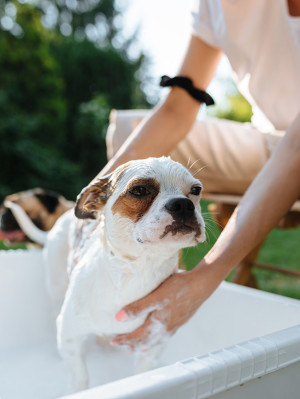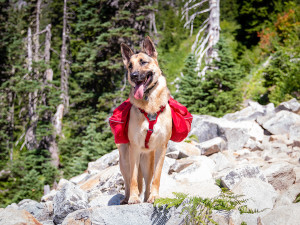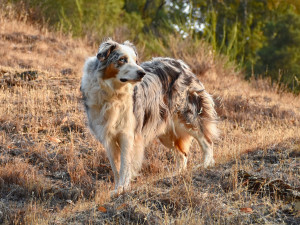Can Dogs Get Poison Ivy?
It’s worth asking, especially ahead of all those hikes you’ll take together this summer.

share article

Your pet wants you to read our newsletter. (Then give them a treat.)
In This Article:
Are Dogs Allergic to Poison Ivy? opens in a new tabDog Poison Ivy Symptomsopens in a new tab What Happens If a Dog Eats Poison Ivy?opens in a new tab How to Treat Dogs With Poison Ivy opens in a new tabPreventing Exposure opens in a new tabFrequently Asked Questionsopens in a new tab
While human skin reacts with painful rashes to some plants like poison ivy, poison oak, and poison sumac, dogs’ skin doesn’t seem to have the same reaction. This may be due to a combination of protective fur and a lack of an allergic response to the irritant in poison ivy.
Are dogs allergic to poison ivy?
If your dog has ever developed a red, itchy spot after exploring a wooded area, you may have wondered “can dogs get poison oak or ivy?” Poison ivy, oak, and sumac contain urushiol oil, which is found in the plants’ sticky sap. This oil causes a severe allergic reaction in most people but doesn’t cause an appreciable reaction in most dogs. In fact, there has not been a documented case of a confirmed poison ivy reaction in dogs.
Dogs can develop an allergyopens in a new tab to almost any substance, so it’s possible that a dog could develop an allergy to poison ivy with repeated exposure. Even if they’re exposed to poison ivy, a dog’s coat will keep their skin protected from the oils present in the sap, which tends to stick to whatever it touches. Sticking to the surface of the hair may also help limit the development of allergies by dogs by decreasing the amount of urushiol oil that touches their skin.
Dog poison ivy symptoms
Because there have been no documented cases of poison ivy causing problems in dogs, it’s hard to know exactly what a poison ivy rash on a dog would look like. In humans, poison ivy causes a contact dermatitis, which features:
Reddened skin
Local swelling
Blisters
Raised bumps (papules)
Depending on the amount of previous exposure to poison ivy, these symptoms may take a week or more to show up. The severity of the lesions and how quickly they appear tend to increase with repeated exposures as the body develops a more severe allergic reaction to the oil.
Some people have a severe enough allergy that they can develop anaphylactic shock from poison ivy. Most rashes resolve within a couple of weeks, but some can take a month or more to clear. Repeated exposure is possible if the person who contacted the plant spread the oil to other objects like doorknobs and clothing.
What other things can look like poison ivy on dogs?
Because it’s very unlikely that your dog got a poison ivy rash after running through foliage, it’s helpful to recognize other skin conditions that could be confused with irritation caused by the plant. Many skin problems in dogs share features with the irritation caused by poison ivy. Some common conditions include:
Atopy
Food allergies
Pyoderma (bacterial skin infection)
Dogs can suffer contact allergies from some plants as well. Plants in the Commelinaceae family, like the inch plant, can cause dermatitis in dogs. This is usually less severe than a poison ivy rash. You may see thickened skin, itchiness, and redness in unhaired areas that were exposed to the plant.
What happens if a dog eats poison ivy?
If your dog ate poison ivy, don’t worry. It’s generally not harmful to dogs because it doesn’t trigger the same allergic response that it does in people. Eating any plant can cause stomach upset for dogs, so vomiting after ingestion is possible. If your dog eats poison ivy, keep an eye out for any symptoms of nausea, diarrheaopens in a new tab, drooling, or discomfort just to make sure your dog isn’t having a problem.
How to treat dogs with poison ivy
Because dogs shouldn’t get rashes from poison ivy, dog poison ivy treatment is usually pretty straightforward. The primary aim is getting the oils off their coat. You may wonder if you can get poison ivy from a dog, and unfortunately, you can. Dogs who have run through poison ivy can spread it to their parents or any objects around the house.
Decontaminating a dog exposed to poison ivy requires bathing, but you should work to protect yourself before starting. Wear a long-sleeved shirt and long pants, as well as waterproof gloves (long dish gloves may be ideal). The oils that cause poison ivy rashes can be broken down and removed with soaps and detergents. The best way to remove oily residue is to bathe your dogopens in a new tab with a dish soap like Dawn because dish soaps are made to get rid of greasy substances.
If your dog has sensitive skin, it may be better to stick with a dog shampoo and employ a lather, rinse, and repeat method. There are products made for humans to help remove urushiol oil, but these have not been evaluated for use in dogs and could cause skin irritation.
If the weather allows, it may be best to bathe your dog outside to limit the areas of your house that you’re exposing to poison ivy. Lather your dog up well, paying special attention to their paws, face, and sides. Massage well and make sure all areas are covered before rinsing and drying. Throw away any disposable materials, like gloves, and immediately wash any clothes you were wearing alone in a hot cycle with detergent.
If you’re worried that your dog is having symptoms from poison ivy exposure or just having bad skin issues in general, it’s always best to contact your veterinarian first. They can guide you on the best treatment and let you know if your dog requires medical care.
Preventing exposure
Finding a way to limit poison ivy on dogs’ coats and paws can be a challenge. Dogs can’t count (not in the traditional wayopens in a new tab, anyway), so teaching them “leaves of three, let them be” isn’t going to be super helpful. This doesn’t mean that you can’t take steps to try to keep your dog away from poison ivy though. You can help control poison ivy exposure to your dog through:
Education
There are numerous resources available online about poison ivy, but the Poison Ivy, Oak, and Sumac Information Centeropens in a new tab is one of the best, providing a no-nonsense, factual overview of all aspects of the plants and the problems they cause. Their resources can help you recognize these irritating plants in your environment.
Removal
If you know you have poison ivy, poison oak, or poison sumac in your yard, removing it is the easiest way to prevent exposure for both you and your dog. Having a professional remove the plant is safest. If you decide to remove it yourself, follow published guidelines to get rid of the plant completely and prevent it from coming back.
Precaution
Never mow or burn poison ivy plants. Mowing spreads the oil over a wide area and breaks the plant down, which exposes more of the irritating oil. The oil can persist in the environment for years, so mowing can create a situation that causes problems for a long time. Burning is even worse, because the oil can be carried by the smoke and end up in your lungs. This can cause severe airway swelling and irritation that can result in death in people.
Avoidance
Poison ivy, oak, or sumac are found in almost all regions of the United States and southern Canada. Dogs can run into the plant in almost any area with natural plant growth. Keep your dog on-leash and in sightopens in a new tab to prevent them from bringing home an unpleasant surprise.
FAQs (People also ask):
How can I safely hike with my dog?
Some dogs love adventuringopens in a new tab with their parents, but they should be kept controlled at all times. This means keeping them in sight so you can watch out for dangers that they’re unaware of.
Are dogs allergic to poison ivy?
Dogs are not allergic to poison ivy, and there are no documented cases of a poison ivy rash developing in a dog. Other skin conditionsopens in a new tab may look like poison ivy in dogs though, so it’s best to get any areas of skin irritation checked by a vet.
What plants are toxic for dogs?
Many plants are toxic to dogsopens in a new tab. Sago palms are a popular decorative plant and can cause acute liver failure in dogs. Peace liliesopens in a new tab are known to cause vomiting, diarrhea, and oral irritation.
References:
Poison Ivy, Oak, and Sumac Information Centeropens in a new tab
ASPCA Animal Poison Control Center Toxic and Non-toxic Plantsopens in a new tab

Dr. Bartley Harrison, DVM
Dr. Bartley Harrison, DVM is a small animal veterinarian based in North Carolina who has practiced emergency medicine since graduating from the Texas A&M College of Veterinary Medicine. His primary interest areas include pain management, cardiology, and the treatment of shock.
He is a member of the Veterinary Emergency and Critical Care Society, American Veterinary Medical Association, and American Medical Writers Association. In addition to his clinical work, he writes pet health articles to help provide accurate information for both new and experienced pet parents. When he’s not working, he enjoys cooking, traveling, reading, and going on adventures with his dog.
Related articles
![A man with a dog on a hike stoping to enjoy a beautiful overlook on a cliff.]() opens in a new tab
opens in a new tabHow to Take Silly Little Mental Health Hikes With Your Dog
It’s good for you both — promise.
![A German Shepherd dog wearing a red hiking backpack on a rocky trail.]() opens in a new tab
opens in a new tab11 Must-Have Items to Take on a Hike with Your Pup
When heading out on a hike with your dog, the items you pack will vary from trip to trip and dog to dog, but there are a few things that every hiker should have packed. Here are the top ten hiking essentials for pet parents. Don’t forget these hiking essentials.
![Australian Shepherd on a hill during golden hour]() opens in a new tab
opens in a new tabHow To Hike With Your Dog
How to get your gear — and your pup — ready to go.
![A woman walking with her dog in a garden.]() opens in a new tab
opens in a new tabHow to Take Your Dog On a Mindful Nature Walk
Wellness experts and animal trainers agree: a tuned-in spring outing can be restorative for both people and pets.
![A woman sitting in a chair holding a dogs paw in her hand and holding the dogs face in the other hand.]() opens in a new tab
opens in a new tab6 Natural Paw Balms That Will Keep Your Pup Safe From Summer Heat
The best paw balms, based on veterinarian recommendations.
![Basset Hound sitting in a bright sunny apartment beside a potted palm tree]() opens in a new tab
opens in a new tabGarden Variety: Plants Safe for Our Pups
Boutique NYC nursery The Sill gives us the dirt on dog-friendly plants.








